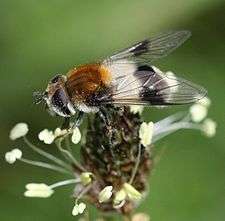Leucozona lucorum
Leucozona lucorum is a Palearctic and Nearctic species of hoverfly.[1][2][3]
| Leucozona lucorum | |
|---|---|
 | |
| male | |
 | |
| female | |
| Scientific classification | |
| Kingdom: | |
| Phylum: | |
| Class: | |
| Order: | |
| Family: | |
| Genus: | |
| Subgenus: | Leucozona |
| Species: | L. lucorum |
| Binomial name | |
| Leucozona lucorum | |
| Synonyms | |
Description
Leucozona lucorum typically has a wing length of 7 ·75–10 mm. The face is yellow-dusted either side of the shining black median area. The thorax is yellowish-green with long reddish hairs, whilst the scutellum is yellow. The abdomen is black with long and abundant, partly pale yellow or whitish yellow and partly black hairs. A conspicuous brown spot can be found on the wings. The male genitalia and larva are figured by Dusek and Laska (1967).[4] The larva is figured in colour by Rotheray (1994).[5] See references for determination.[6] [7] [8][9]
Distribution
Leucozona lucorum is widely distributed across the Palearctic and the Nearctic regions. In the Palearctic, it occurs from Fennoscandia south to the Pyrenees and North Spain and from Ireland east through North and Central Europe into Turkey and European Russia, the Russian Far East and Siberia and the Pacific coast (Kuril Islands and Japan). It is common in England. In the Nearctic, it occurs from Alaska south to Oregon and New York. [10] [11]
Biology
The typical habitat of the species consists of deciduous forest, especially around woodland rides and edges or unimproved montane grassland. [12][13] Flowers visited include white umbellifers, Acer pseudoplatanus, Centaurea, Cirsium palustre, Euphorbia, Filipendula, Polygonum cuspidatum, Rubus, Sorbus aucuparia, Taraxacum.[14] The flight period is May to August, normally peaking in June. The larvae feed on aphids on ground flora.
External Links
References
- Ball, S.G.; Morris, R.K.A. (2000). Provisional atlas of British hoverflies (Diptera, Syrphidae). Monks Wood, UK: Biological Record Centre. pp. 167 pages. ISBN 1-870393-54-6.
- Morris, Roger, K. A. (1999). Hoverflies of Surrey. Surrey Wildlife Trust. p. 244. ISBN 0-9526065-3-4.CS1 maint: multiple names: authors list (link)
- Stubbs, Alan E.; Falk, Steven J. (1983). British Hoverflies: An Illustrated Identification Guide. British Entomological & Natural History Society. p. 253, xvpp.
- Dusek, J. & Laska, P. (1967) Versuch zum aufbau eines Naturlichen Systems mitteleuropaischer Arten der Unterfamilie Syrphinae (Diptera). Acta sc.nat.Brno, 1: 349-390.
- Rotheray G., 1993 Colour Guide to Hoverfly Larvae Diptera, Syrphidae in Britain and Europe Dipterists Forum pdf
- Van Veen, M. (2004) Hoverflies of Northwest Europe: identification keys to the Syrphidae. 256pp. KNNV Publishing, Utrecht.addendum
- Van der Goot,V.S. (1981) De zweefvliegen van Noordwest - Europa en Europees Rusland, in het bijzonder van de Benelux. KNNV, Uitgave no.32: 275pp. Amsterdam.
- Bei-Bienko, G.Y. & Steyskal, G.C. (1988) Keys to the Insects of the European Part of the USSR, Volume V: Diptera and Siphonaptera, Part I. Amerind Publishing Co., New Delhi. ISBN 81-205-0080-6.
- Coe, R.L. (1953) Diptera: Syrphidae. Handbks.ident.Br.insects, 10(1): 1-98. R.ent.Soc.London. pdf
- "Leucozona lucorum". Fauna Europaea. Retrieved 6 July 2020.
- Vockeroth, J. R. (1992). The Flower Flies of the Subfamily Syrphinae of Canada, Alaska, and Greenland (Diptera: Syrphidae). Part 18. The Insects and Arachnids of Canada. Ottawa, Ontario: Canadian Government Pub Centre. pp. 1–456. ISBN 0-660-13830-1.
- "Leucozona lucorum". Eakring Birds. Retrieved 6 July 2020.
- Speight, M.C.D. (2011). "Species accounts of European Syrphidae (Diptera)" (PDF). Syrph the Net, the database of European Syrphidae. 65: 285pp.
- de Buck, N. (1990) Bloembezoek en bestuivingsecologie van Zweefvliegen (Diptera, Syrphidae) in het bijzonder voor België. Doc.Trav. IRSNB, no.60, 1-167.